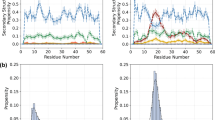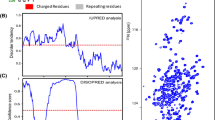Abstract
While chemical shift prediction has played an important role in aspects of protein NMR that include identification of secondary structure, generation of torsion angle constraints for structure determination, and assignment of resonances in spectra of intrinsically disordered proteins, interest has arisen more recently in using it in alternate assignment strategies for crosspeaks in 1H–15N HSQC spectra of sparsely labeled proteins. One such approach involves correlation of crosspeaks in the spectrum of the native protein with those observed in the spectrum of the denatured protein, followed by assignment of the peaks in the latter spectrum. As in the case of disordered proteins, predicted chemical shifts can aid in these assignments. Some previously developed empirical formulas for chemical shift prediction have depended on basis data sets of 20 pentapeptides. In each case the central residue was varied among the 20 amino common acids, with the flanking residues held constant throughout the given series. However, previous choices of solvent conditions and flanking residues make the parameters in these formulas less than ideal for general application to denatured proteins. Here, we report 1H and 15N shifts for a set of alanine based pentapeptides under the low pH urea denaturing conditions that are more appropriate for sparse label assignments. New parameters have been derived and a Perl script was created to facilitate comparison with other parameter sets. A small, but significant, improvement in shift predictions for denatured ubiquitin is demonstrated.


Similar content being viewed by others
References
Bennion BJ, Daggett V (2003) The molecular basis for the chemical denaturation of proteins by urea. Proc Natl Acad Sci USA 100:5142–5147
Camilloni C, De Simone A, Vranken WF, Vendruscolo M (2012) Determination of secondary structure populations in disordered states of proteins using nuclear magnetic resonance chemical shifts. Biochemistry 51:2224–2231
De Simone A, Cavalli A, Hsu STD, Vranken W, Vendruscolo M (2009) Accurate random coil chemical shifts from an analysis of loop regions in native states of proteins. J Am Chem Soc 131:16332
Dutta A, Saxena K, Schwalbe H, Klein-Seetharaman J (2012) Isotope labeling in mammalian cells. In: Shekhtman A, Burz DS (eds) Protein NMR techniques. Methods in molecular biology, vol 831, 3 edn. Humana Press, Totowa, NJ, pp 55–69
Dyson HJ, Wright PE (2005) Intrinsically unstructured proteins and their functions. Nat Rev Mol Cell Biol 6:197–208
Feng L, Lee HS, Prestegard JH (2007) NMR resonance assignments for sparsely 15N labeled proteins. J Biomol NMR 38:213–219
Gossert AD, Hinniger A, Gutmann S, Jahnke W, Strauss A, Fernandez C (2011) A simple protocol for amino acid type selective isotope labeling in insect cells with improved yields and high reproducibility. J Biomol NMR 51:449–456
Kemmink J, Creighton TE (1993) Local conformations of peptides representing the entire sequence of bovine pancreatic trypsin-inhibitor and their roles in folding. J Mol Biol 234:861–878
Kjaergaard M, Poulsen FM (2011) Sequence correction of random coil chemical shifts: correlation between neighbor correction factors and changes in the Ramachandran distribution. J Biomol NMR 50:157–165
Lange OF, Rossi P, Sgourakis NG, Song YF, Lee HW, Aramini JM, Ertekin A, Xiao R, Acton TB, Montelione GT, Baker D (2012) Determination of solution structures of proteins up to 40 kDa using CS-Rosetta with sparse NMR data from deuterated samples. Proc Natl Acad Sci USA 109:10873–10878
Li WF, Qin M, Tie ZX, Wang W (2011) Effects of solvents on the intrinsic propensity of peptide backbone conformations. Phys Rev E 84:041933
Marsh JA, Singh VK, Jia Z, Forman-Kay JD (2006) Sensitivity of secondary structure propensities to sequence differences between alpha- and gamma-synuclein: implications for fibrillation. Protein Sci 15:2795–2804
Nkari WK, Prestegard JH (2009) NMR resonance assignments of sparsely labeled proteins: amide proton exchange correlations in native and denatured states. J Am Chem Soc 131:5344–5349
Peti W, Smith LJ, Redfield C, Schwalbe H (2001) Chemical shifts in denatured proteins: resonance assignments for denatured ubiquitin and comparisons with other denatured proteins. J Biomol NMR 19:153–165
Raman S, Lange OF, Rossi P, Tyka M, Wang X, Aramini J, Liu GH, Ramelot TA, Eletsky A, Szyperski T, Kennedy MA, Prestegard J, Montelione GT, Baker D (2010) NMR structure determination for larger proteins using backbone-only data. Science 327:1014–1018
Rezaei-Ghaleh N, Blackledge M, Zweckstetter M (2012) Intrinsically disordered proteins: from sequence and conformational properties toward drug discovery. ChemBioChem 13:930–950
Schwarzinger S, Kroon GJ, Foss TR, Chung J, Wright PE, Dyson HJ (2001) Sequence-dependent correction of random coil NMR chemical shifts. J Am Chem Soc 123:2970–2978
Shen Y, Delaglio F, Cornilescu G, Bax A (2009) TALOS+: a hybrid method for predicting protein backbone torsion angles from NMR chemical shifts. J Biomol NMR 44:213–223
Shi ZS, Chen K, Liu ZG, Kallenbach NR (2006) Conformation of the backbone in unfolded proteins. Chem Rev 106:1877–1897
Takeuchi K, Ng E, Malia TJ, Wagner G (2007) 1-13C amino acid selective labeling in a 2H15N background for NMR studies of large proteins. J Biomol NMR 38:89–98
Tamiola K, Acar B, Mulder FA (2010) Sequence-specific random coil chemical shifts of intrinsically disordered proteins. J Am Chem Soc 132:18000–18003
Ting D, Wang GL, Shapovalov M, Mitra R, Jordan MI, Dunbrack RL (2010) Neighbor-dependent Ramachandran probability distributions of amino acids developed from a hierarchical dirichlet process model. PLoS Comput Biol 6:e1000763
Wang Y, Jardetzky O (2002a) Investigation of the neighboring residue effects on protein chemical shifts. J Am Chem Soc 124:14075–14084
Wang Y, Jardetzky O (2002b) Probability-based protein secondary structure identification using combined NMR chemical-shift data. Protein Sci 11:852–861
Wishart DS, Bigam CG, Holm A, Hodges RS, Sykes BD (1995a) 1H, 13C and 15N random coil NMR chemical shifts of the common amino acids. I. Investigations of nearest-neighbor effects. J Biomol NMR 5:67–81
Wishart DS, Bigam CG, Yao J, Abildgaard F, Dyson HJ, Oldfield E, Markley JL, Sykes BD (1995b) H-1, C-13 AND N-15 chemical-shift referencing in biomolecular NMR. J Biomol NMR 6:135–140
Acknowledgments
This work was supported by grants from the NIH to the Resource for Integrated Glycotechnology at the University of Georgia (P41 RR005351-23 and P41 GM103390-23), to JHP for research support (R01 GM061268-09), from the NIH to J. L. Urbauer from the Shared Instrumentation Program for upgrading an NMR console (S10RR027097-01A1) and to DL from the Shared Instrumentation Program for the purchase of the peptide synthesizer (1S10 RR027155-01).
Author information
Authors and Affiliations
Corresponding author
Rights and permissions
About this article
Cite this article
Prestegard, J.H., Sahu, S.C., Nkari, W.K. et al. Chemical shift prediction for denatured proteins. J Biomol NMR 55, 201–209 (2013). https://doi.org/10.1007/s10858-012-9702-x
Received:
Accepted:
Published:
Issue Date:
DOI: https://doi.org/10.1007/s10858-012-9702-x




